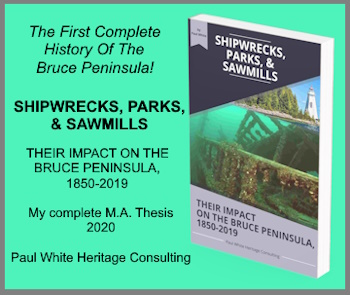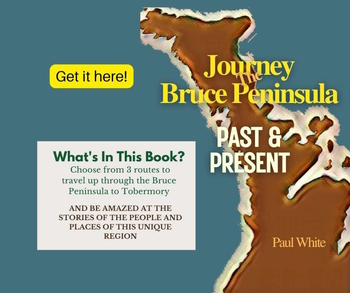A Pioneer Road Surveyor's Impact on Local History
A pioneer road surveyor's impact on the local history of Grey and Bruce counties could have been dramatic, if it had not been changed by another surveyor.
The intersection of Highways #6 and #10 at the north end of the village of Chatsworth has long been a sign to road-weary travellers heading to Owen Sound that their trip is almost complete.
This junction in Chatsworth marks the diversion of the two major routes in to, and out of, the area. Highway #10, formerly the Toronto-Sydenham Road, leads to Orangeville, Brampton, and finally Toronto.
Highway #6, originally the Garafraxa Road, connects this area with the Guelph, Kitchener, and Hamilton region. However, if an 1843, a pioneer road surveyor's for the region had been accepted, the future of this area, especially the village of Chatsworth, and possibly Owen Sound, might have been very different.
In 1843, the Commissioner of Crown Lands assigned John S. Dennis, deputy provincial surveyor, the task of surveying a township south of the Sydenham settlement. The new township was to be called Sullivan in honour of Robert Baldwin Sullivan, who just happened to also be the current Commissioner of Crown Lands.
When the surveyor submitted his plans for Sullivan Township to the Commissioner of Crown Lands in the autumn of 1843, he included a noteworthy proposal.
Whether his assignment called for Dennis to also survey a road through the area is not clear. Dennis marked the northern boundary of the new township with a road which he called "Mr. Hawkins' Line".
A road as a township boundary is not a unique concept. But it was Dennis' idea that "Mr. Hawkins' Line" was more than a simple boundary road. This section of road was part of a greater plan to build a road connecting Toronto with the mouth of the Saugeen River, totally bypassing the new community of Sydenham (Owen Sound). This proposed road would intersect with the Garafraxa Road about half-way between the present-day communities of Chatsworth and Williamsford. However, this plan never was implemented.
Before Dennis had even completed his survey, John Telfer, the land agent for the area, wrote to the Commissioner of Crown Lands, requesting further directions concerning where he should locate settlers. The land agent envisioned in his letter a tier of townships extending southward from Sydenham (Owen Sound). It seems that his conception of a township extended to the idea of 30 lots of 200 acres each on either side of the road.
It seems that at the time of Telfer's correspondence with the Commissioner of Crown Lands he was in the process of issuing land lots to settlers in the second tier of townships, Holland and Sullivan. To meet these demands for land, in the fall of 1845, Charles Rankin was ordered to survey two more concessions in Sullivan Township.
During the process of surveying Sullivan Township, Rankin made a dramatic change to the original survey by Dennis which had been completed two years earlier. Dennis had determined that the boundary between Sullivan and Derby should be "Mr. Hawkins' Road". Because of the angle of this route, which would ultimately connect Toronto with the mouth the Saugeen River, the township had an uneven shape. Rankin's survey ignored the possibility of such a route and moved the north-eastern boundary of Sullivan northward to give the township a more constant shape.
The Commissioner of Crown Lands accepted Rankin's proposed survey, and Dennis' dream of a road connecting Toronto with the mouth of the Saugeen River disappeared.
One has to wonder whether Telfer wrote his letter to the Commissioner of Crown Lands with a motive which extended far beyond the idea of receiving instruction with regard to placing settlers on plots of land.
The question has to be asked whether Telfer, seeing that the pioneer road surveyor, Dennis's proposed road between Toronto and the mouth of the Saugeen did not provide a direct access route for the community of Sydenham to Toronto, hoped to circumvent this plan.
After all, if "Mr. Hawkins' Road" was built the dreams of the Sydenham settlement would have been dealt a serious blow to its aspirations for growth and development.
If Rankin had not changed the boundaries of Sullivan Township the future might have been entirely different in the Grey and Bruce region.
The information used in this article came from many different sources. However, of primary importance was The History of Sullivan Township, 1850-1975.
A version of "A Pioneer Road Surveyor's Impact on Local History," originally appeared in my Local History column in the January 14, 2000 edition of the Owen Sound Sun Times.
More Grey County Pages
12-year-old Walks to Owen Sound in 1851 from the journal of a teenage boy's experience travelling with his brother in the untamed Upper Canadian wilderness.
1st Grey County Building in 1852 was only built after many hurdles were overcame.
Dr. Anna Henry from Markdale, was a medical trailblazer for women doctors in Canada, who helped lay the groundwork for the establishment for Women's College Hospital.
Egremont Township endured the usual growing pains of a pioneer community, but its early history records times when it was embroiled in a few contentious issues.
Euphrasia Township in the early years when spelling the name was a problem for those who called it home and those that wanted settle this new Grey County township.
Georgian Bay's 1st pioneer settler arrived on the western shoreline long before any other settler reached the area.
Grey County Heritage: A Valuable Resource which is rich and varied, as an important resource for future use for business, political, and many other purposes.
Grey County's Creation in 1852, laid the framework for organizing a county in the last wilderness in the southern region of what would become in the future the province of Ontario.
An Unlikely Hero From Grey County (Part 1) found his way from the farming community of Flesherton to missionary work in the Ottawa Valley, and beyond.
An Unlikely Hero Vs. The KKK (Part 2) Our hero from Grey County took his missionary zeal south of the border and ultimately crossed paths with the infamous KKK!
Barn Raising: A Pioneer Economic and Social Necessity as it provided settlers with an opportunity not only to build a barn, but also build a community.
"Barring Out": A Pioneer School Tradition was a custom which the settlers brought to the new world from England, or Scotland.
Ceylon Ontario: How it Got its Name: It is always interesting how a community got its name, but I doubt any place received its name from a more unique source!
Chatsworth Ontario: First Settlers took advantage of fulfilling the needs of pioneer travellers and built a thriving community in the Upper Canadian wilderness.
Clearing Trees a Daunting Task for Settlers as they worked to fulfill their obligations for their land grant.
Dornoch: or is it Smithville? Originally it was Smithville, then it became Dornoch. But, surprise it is still, in reality Smithville!
First Pioneer in Durham: Archibald Hunter established his family, and a hotel, in what would become the centre of the town of Durham.
Durham Ontario Influenced by the Saugeen River. This river provided a means to create new industries, but especially in the spring it can also pose a menace to the community.
Grey County Bylaws to the 1890s reveal a lot about the financing of local government, especially education in the early days of the region.
John Muir, the legendary naturalist, who promoted the idea of protected nature spaces, spent time in Ontario and I went to help find evidence of his stay in the Owen Sound area.
A Heroic Woman From Grey County who made great changes as a doctor in China in the 1890s and early 1900s.
Jesse James: In Grey County? An interesting question. Did the notorious gangster hide out in Proton Township? We will never know. But it is fun to speculate!
Kilsyth's Train Engine was one for the history books. It brought an evening of joy followed by disappointing news soon after.
The Knight's of Meaford have long history in that Grey County community. Their business forged by early settlers employed many locals and supported the economy.
Leith: Tom Thomson's Birthplace is part of the rich heritage of this community located on the east shore of the Georgian Bay north of Owen Sound.
The Leith Golf Course has provided many families with great memories. The history of this golf course starts, and ends, with the generosity of one family.
Agnes Macphail was a political trailblazer in a part of Ontario that one could hardly expect such radical action for the era in a rural region.
Markdale Ontario: The Beginning: originally known as Glenelg East, but the coming of the railway and the name of owner of the land for the station led to a change of identity.
Meaford's history is one of hardy and entrepreneurial pioneers carving their lives out of the wilderness of what would become Grey County.
Meaford Ontario, first called Peggy's Landing located on the shores of Georgian Bay has a rich history.
Meaford vs Purdytown. Conflict over the name of a new community was not unusual in early Grey County but electing a school trustee was the "hot button" issue in this rivalry.
Pioneer Clergyman: John Neelands was the first to minister to the first settlers' spiritual needs riding on horseback through the wilds of early Grey County.
Pioneer Doctor: Dr. James Smith, a local boy who became a doctor and served his community for his entire life was a testament to Grey County community spirit.
Pioneer Healthcare in Grey and Bruce counties was not administered by doctors, nurses, or pharmacists, no it was the responsibility of the women of the community.
Pioneer Homes in Grey County in the 1840s offered only basic amenities. Homes were basic because clearing the land to earn a living to survive were of paramount importance for those embarking on a new life.
Pioneer Ingenuity created many labour saving devices and methods and quite often helped to create a sense of community.
Pioneer Christmas: A Family Tradition as told to me by may grandparents who experienced Christmas as children in the 1880s and 1890s.
Pioneer Settlement Plans for Grey County began almost two decades before the rest of Grey County was available for settlement.
A pioneer road surveyor's impact on the local history of Grey and Bruce counties could have been dramatic, if it had not been changed by another surveyor.
Pioneer Teachers in Grey and Bruce Counties had a long and arduous task, not to mentions strict and confining job requirements for very little salary.
Plowing Match in Grey County in 1933 the first International Plowing Match held in Grey and Bruce counties and it's success led to more such events in Grey.
Settling Osprey Township: Parts of Osprey were considered too rugged to settle, but today they are prime real estate because of the great view!
Swamp College: Proton Township: this colourfully named institution of education in Grey County has provided many stories to the heritage of the region.
Sydenham Township's First Council undertook the often difficult task of creating a new municipal infrastructure.
The Impact of Snow is not what is Used to be! As snow removal equipment has improved the impact of snow on our lives has reduced significantly from previous eras.
Unique Characters: Nathaniel Herriman lived in Grey County and owned an inn to provide food and and accommodation to early travellers. Each day he performed a unique practice.
Unique Maps: Quilts Guided the Underground Railroad to enable runaway slaves to escape to Canada and freedom from the shackles that enslaved them.
The Women's Institute is a group of rural women that has made a difference to the quality of both urban and rural life in Grey County and across the country.





